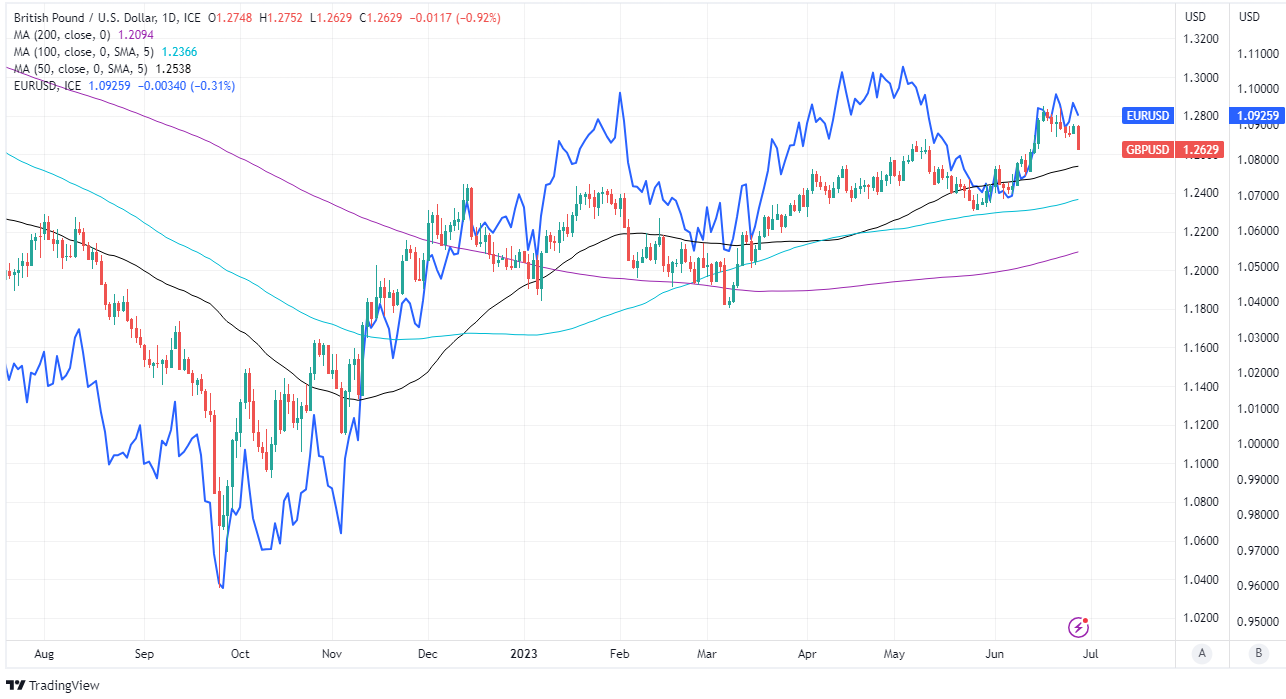Pound Sterling's "Extremely Long" Positioning Draws Would Be Seller
- Written by: James Skinner
-
"This is the largest 1-week change ever in GBP positioning and brings overall positioning into the 95th percentile at +46,608 contracts" - Spectra Markets.

Image © Adobe Images
The recently popular Pound still retains some recent gains in relation to many currencies including the Dollar but a record increase in speculative buying over the recent week and a history of losses in these circumstances led some to view it as a short-selling opportunity.
Sterling had the wind in its sails until recently but a nascent rebound by the U.S. Dollar and a huge run-up in bond yields and market-implied expectations for the Bank of England (BoE) Bank Rate have stalled the Pound's rally since mid-month before driving the correction now underway.
"I am short the GBP/USD as I think the conundrum that the UK economy and the BoE are facing is starting to come to a head and I expect the currency to take the brunt of the pain going forward. EUR/USD looks like a short as well, but I haven't pulled the trigger here just yet," says Brad Bechtel, global head of FX at Jefferies.
An acceleration of wage growth, a resilient economy and a rebound in core inflation have led the market-implied Bank Rate for year-end to reach 6.25% in recent weeks and prompted the BoE to raise the benchmark from 4.5% to 5% last Thursday but Sterling has lost ground to the Dollar since then.
Above: selected moving averages denote support and/or resistance for Pound to Dollar rate. Shown at daily intervals and alongside EUR/USD. Click for closer inspection.
"GBP did not broadly outperform following this week’s surprise 50bp hike, and we’ve found that the GBP TWI has struggled to outperform following its high-side CPI surprises in recent months. This suggests that the higher nominal rates impact may be starting to fatigue for at least some currencies," says Meera Chandan, head of FX research at J.P. Morgan.
Dollars have been bought widely in this time but so too has Sterling with the speculative market now having grown its 'long' position at the fastest rate on record over the same period, which creates a risk of any future losses being exacerbated if that segment of the market heads for the exits at the same time.
The increase in speculative appetites for the Pound might have kept it from falling further in recent trade but could become more than just a statistical risk if the latest economic growth numbers from the UK underwhelm on Friday, or if U.S. inflation figures go the wrong way for the Federal Reserve on Friday.
"Recent sterling weakness may be a matter of simple profit-taking, as traders lighten longs after the pound's recent rise near 2023 highs in the mid-1.28s. Sterling speculative traders had bought a gargantuan 39,873 contracts, as per the most recent IMM spec data, and with no follow-through higher may be unloading weak longs ahead of an uncertain near-term inflation and rate landscape as well as next week's U.S. holiday," says Paul Spirgel, a Reuters market analyst.
Source: Spectra Markets.
"GBP positioning is extremely long (see positioning report, next page) but I don’t see a catalyst right here right now that makes me want to take the other side," says Brent Donnelly, CEO at Spectra Markets and a veteran FX trader with a career spent between hedge funds and global banks like HSBC and Nomura.
"This is the largest 1-week change ever in GBP positioning and brings overall positioning into the 95th percentile at +46,608 contracts. As a general rule, CFTC positioning is directional and trend-following, but GBP at these levels of positioning is a rare exception," he writes in Tuesday's am/FX daily macro newsletter.
Economist surveys suggest official figures will confirm the UK economy grew 0.1% in the opening quarter on Friday and just hours before the Fed's preferred measure of inflation is tipped to show the core PCE Price Index inflation rate remaining at 4.7% for the year to the end of May.
Source: Spectra Markets.
Without a catalyst for a deeper correction, however, there is little by way of technical impediment on the charts to keep the Pound to Dollar rate from rising back toward the 1.2850 level seen in early June and this could happen if the current rebound in U.S. exchange rates fizzles out for any reason in the days ahead.
The latter might be especially likely if the Fed's preferred measure of core inflation softens further as this would place a question mark over market expectations for U.S. interest rates to rise again later this year, though some strategists say the currently high level of UK bond yields should also keep the Pound from falling much further.
"The currency reaction to this week’s inflation print had some of the concerning markings of last Autumn, in a sign that the market was starting to question whether policymakers would be up to the challenge," writes Michael Cahill, a G10 FX strategist at Goldman Sachs, in a Friday research briefing.
"We are deeply skeptical of the idea that more aggressive rate increases risks weakening the currency by lowering growth. As long as policymakers remain committed to higher real rates, that should support GBP, while other domestic assets may suffer (such as house prices and equities)," he and colleagues add.
Above: Selected moving averages denote support and/or resistance for Pound to Dollar rate while Fibonacci retracements of selected downtrends indicate possible resistance. Shown at weekly intervals and alongside EUR/USD. Click for closer inspection.


